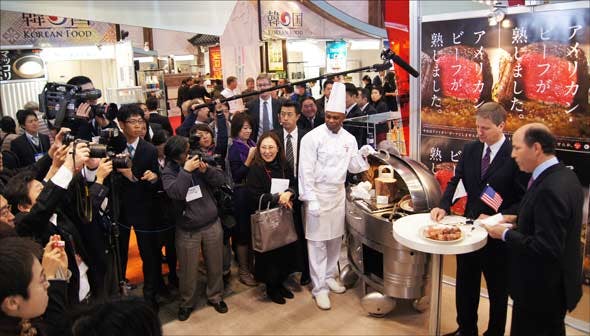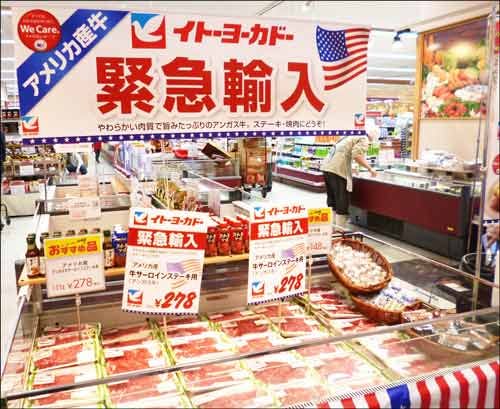Absence Makes the Heart Grow Fonder for U.S. Beef in Japan

Japanese TV stations film Greg Hanes, USMEF assistant vice president for international marketing and programs, and U.S. Ambassador John V. Roos sampling U.S. beef at FoodEx Japan
The Feb. 1 expansion of access for U.S. beef to product from animals 30 months of age and under has been greeted with extreme interest and excitement. Television stations have turned out to capture displays of American beef at trade shows, and retailers, food service operators and processors are reacquainting themselves with the taste of bone-in beef and delicacies including beef tongue.Most important of all, consumers are calling for it.
“American beef has been very popular among Japanese chefs, and this change will surely increase the opportunities for us to develop new menus using prime, Angus and T-bone steak cuts,” said the president of the All Japan Chefs Association. The association, which USMEF has worked closely with over the years, also plans to conduct cooking contests and seminars to involve younger consumers who may not remember bone-in U.S. beef cuts.
In anticipation of the Feb. 1 expansion, USMEF-Japan has been preparing the market since late 2012, and the activity has not slowed at all in the months since. At FoodEx Japan, Asia’s largest food industry exhibition that drew thousands of attendees from 73 countries around the world, the long lines of prospective buyers viewed displays and sampled products ranging from short ribs, short loins (T-bone steaks), porterhouse steaks, offal products including tongue and outside skirts, and branded products.

U.S. beef is prominently displayed at Ito Yokado supermarkets
On the retail front, nationwide supermarket operator Ito Yokado has conducted U.S. beef promotions at outlets in Tokyo that it is expanding to other stores around the country. Ito Yokado has indicated that it intends to double the share of U.S. beef products it sells – from 10 percent of all beef to 20 percent.”Representatives of other leading retailers have indicated that they too will expand their U.S. beef offerings. The meat section manager of the Daiei grocery chain stated that the increased supply of American beef will enable the stores to carry a wider range of products, particularly steaks and yakiniku items as well as tongue and other offal products.
“The response from retailers has been outstanding,” said Koji Mizukami, USMEF marketing manager. “The top grocery chains, including Tokyu Store, Ito Yokado and Daiei, all are working with USMEF on promotions for their customers.”
“After years of efforts in this market, it is really gratifying to see this high level of interest in U.S. beef,” said Greg Hanes, USMEF assistant vice president for international marketing and programs. “Our work with the large retailers is really paying off as they plan to greatly expand their offering of U.S. beef. And with greater supplies, we can expand our reach out to the regional retailers and other segments that didn’t have access to the product earlier.”
One segment of the Japanese restaurant industry that has been eagerly anticipating the increased shipments of U.S. beef is the yakiniku industry.
“Yakiniku consumes a tremendous amount of U.S. beef ribs and plates as well as tongues, outside skirts and intestines,” said Mizukami. “Those companies have been anxiously awaiting the expanded offerings so they can have a wider range of cuts and quality of products to choose from.”

Prospective buyers sampled U.S. short ribs, T-bone steaks, porterhouse steaks, offal products and branded products at FoodEx Japan
USMEF-Japan was heavily represented at the recent National Yakiniku Business Fair, which attracted more than 250 companies and 13,000 visitors. Once again, U.S. beef was the main attraction as all the top importers and distributors featured U.S. beef, including processors’ high-grade branded items.Several key Japanese companies have taken the initiative to promote U.S. products to their own customers. Leading importer/distributors Nippon Ham and Starzen conducted product showcases where they featured under-30-month U.S. beef and offered merchandising ideas for U.S. variety meat products. USMEF supported the meetings with educational and point-of-sale materials.
The increased demand for U.S. beef is expected to significantly drive up exports to that key market in the coming year. Japan’s beef imports from all sources for the first two months of 2013 were down slightly from last year as importers anticipated the availability of under-30-month U.S. beef, but weekly U.S. beef export data through March shows Japan as the top destination as the year progresses.
“The ability to leverage USDA Market Access Program (MAP) funds with support from the industry was critical in our long-term efforts to reestablish this incredibly important market,” added Hanes. “Without maintaining our marketing efforts over the last decade, we would not see the type of excitement we are seeing now.”
In 2012, Japan was the No. 2 value market and No. 3 volume market for U.S. beef exports, purchasing 152,763 metric tons (336.8 million pounds) of product valued at just over $1 billion. Even though the expanded range of U.S. products did not begin arriving in Japan until March, U.S. exports to Japan through February were already running 12 percent higher in value than last year’s totals on 3 percent larger volumes.
